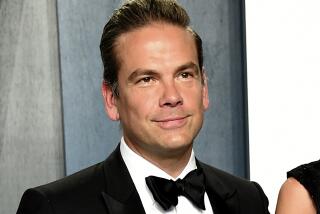Dow Jones CEO to Step Down in Shake-Up
- Share via
NEW YORK — Dow Jones & Co., the publisher of the Wall Street Journal, said Tuesday that its chief executive would step down as part of a management overhaul that would put a nonjournalist at its helm for the first time in decades.
The decision to appoint Chief Operating Officer Richard F. Zannino, 47, as CEO comes amid increasing pressure in the newspaper industry and at Dow Jones, which saw its stock price slide nearly 18% in 2005.
Zannino, a former retail executive, will take over Feb. 1 from Peter R. Kann, a Pulitzer Prize-winning journalist who has been CEO since 1991. Kann will remain chairman until 2007.
Dow Jones also said that Journal Publisher Karen Elliott House, who is married to Kann and was a contender for the CEO job, would leave the company by “mutual agreement.”
The changes signal Dow Jones’ intent to improve its financial performance amid a brutal advertising climate and doubts about the long-term viability of newspapers in the digital age, analysts said.
“The fact that they’re making this announcement on the first trading day of the new year signals that the company is serious about change,” said Douglas Arthur, a Morgan Stanley analyst.
Though Dow Jones stock has suffered along with that of other newspaper companies, the firm remains profitable. In fact, on Tuesday, Dow Jones said it expected to beat earlier fourth-quarter earnings projections because of better performance at the Journal and in its electronic publishing business. Earnings before special items will be about 40 cents a share, compared with the low-to-mid-30-cents-a-share range previously forecast.
Dow Jones shares soared $3.65, or 10.3%, to $39.14.
Newspapers are coming off a tough year as a two-decade decline in readership was exacerbated by the growing popularity of Internet sites for getting news and placing advertising. The Journal has been hard hit by the falloff in technology and financial advertising in the aftermath of the 1990s Internet stock bubble.
Dow Jones has sought to broaden its advertising base in recent years through the introduction of consumer-oriented sections in the Wall Street Journal, which also launched a Saturday edition in September.
Zannino indicated in an interview that diversification efforts would continue, but he said “there are no silver bullets” to solve the problems.
“The strategy going forward will be tweaking a little bit, but it won’t be markedly different from the strategy we had,” he said.
Zannino is the first nonjournalist to lead Dow Jones since Hugh Bancroft was company president from 1928 to 1933. Going outside the newsroom was widely seen as a concession by the Bancroft family, Dow Jones’ controlling shareholders, to the challenges facing the industry.
“That’s a big break with tradition,” said John Morton of newspaper consulting firm Morton Research Inc. “The Bancroft family, although they’ve been steadfast in their support of company management and journalism, is probably unsettled by all the changes swirling in the journalism business.”
Although not a surprise, the transition to Zannino was expected to be a year or more away. Kann, 63, won’t reach the company’s mandatory retirement age until 2007.
With Dow Jones shares trading near multiyear lows, some on Wall Street have speculated that the Bancrofts could be preparing to sell the company. Washington Post Co. has been cited as a possible suitor, and News Corp. Chairman Rupert Murdoch has made no secret of his interest.
Among other advantages, owning Dow Jones could help Murdoch provide content for the business news channel he plans to launch to compete with CNBC, owned by General Electric Co.’s NBC Universal.
Kann insisted that Tuesday’s shake-up was not a precursor to an ownership change.
“I can assure you there is no such plan on anyone’s mind,” he said.
Current and former Journal staffers said they were concerned that Zannino would cut resources and that he might not be as concerned about preventing powerful business interests from influencing news coverage.
“A great strength of the Wall Street Journal, certainly since World War II, has been the strong representation of experienced journalists and journalistic values in senior leadership,” said Frank Allen, a longtime editor who left in 1994.
“When I arrived in 1979,” he said, “the purpose of the daily news huddle was to decide how much space to take away from advertising so you could make a larger news hole.”
Another former Journal editor said Zannino had a quick mind, an accessible manner and a keen focus on the stock price.
“That’s why Wall Street loves him,” said the editor, who did not want his name used because he works for another publication.
Zannino pledged to honor the paper’s high journalistic values and said he wouldn’t cut costs to boost short-term results.
Activist investors such as Boyar Asset Management were cheered by the new leadership as well as the possibility that the company might be sold. Shareholder pressure recently forced newspaper chain Knight Ridder Inc. to the auction block.
“We were never a big fan of Peter Kann. He did an awful job of running the business,” said fund President Mark Boyar. “For the first time since the Bancroft family has owned the company, you have a businessman running the newspaper.”
Boyar said Zannino had plenty to fix without having to interfere with the newsroom. Given its affluent readership, Boyar said, the Journal should do a better job of attracting high-end advertising.
*
(BEGIN TEXT OF INFOBOX)
At a glance
Dow Jones & Co.
Headquarters: New York
Founded: 1882
Employees: 7,143
Chief executive: Peter R. Kann*
Ownership: Stock trades on the New York Stock Exchange. The Bancroft family controls the majority of voting stock.
2004 revenue: $1.67 billion
Holdings: Wall Street Journal, Barron’s, Dow Jones Newswires
Other ventures: Co-owner of Factiva, SmartMoney and CNBC TV operations in Europe and Asia
*Richard F. Zannino named CEO as of Feb. 1
Sources: Hoover’s, Dow Jones & Co.
*
Hamilton reported from New York and Menn from San Francisco. Times staff writer Sallie Hofmeister in Los Angeles contributed to this report.
More to Read
Inside the business of entertainment
The Wide Shot brings you news, analysis and insights on everything from streaming wars to production — and what it all means for the future.
You may occasionally receive promotional content from the Los Angeles Times.










